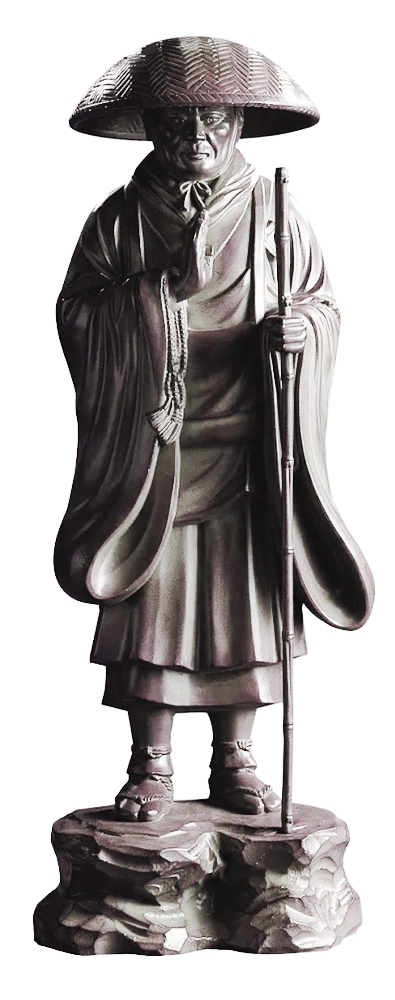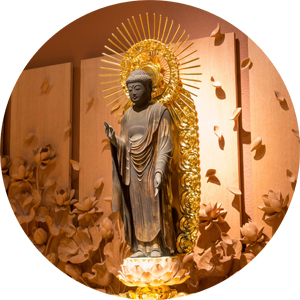Ⅳ03. Neither a monk nor an layperson
Mahayana Buddhism has three features. The first is its sociality that seeks to interact with all things. The second is its universality that applies to all things. The third is its equality that wants to save all things.
Shinran was a Mahayana Buddhist who pursued the teaching that all things can be saved.
Is it possible to attain enlightenment only if one becomes a monk who strictly observes the precepts? If that is the case, ordinary people, who have no choice but to live a life filled with worldly desires, would not be able to attain Buddhahood.
Is it possible to become a Buddha if one is not a good person? If not, then those who recognize themselves as an evil person would not be able to attain Buddhahood.
If there are necessary conditions for salvation that must be done, then those who cannot do them will not be saved. Mahayana Buddhism is something that anyone can practice, and the potential for enlightenment should be open to everyone depending on their own awareness.
Shinran was a man who did not follow the Buddhist precepts, was aware of his own evilness, and lived as part of society, yet embodied the path to enlightenment.

For twenty-six years from age nine, Shinran pursued a career as a state-recognized scholar-monk. However, after he was subjected to religious persecution by political authorities at the age of 35, he never again called himself a monk for the rest of his life.
He declared that he was “Hisou-hizoku (neither a monk nor an layperson)” and never called himself a “monk.”
This was a time when one was not socially recognized as a monk unless he had the backing of political power. Shinran was not an officially recognized professional monk. He was a man who lived his daily life as an ordinary citizen.
However, Shinran was not a worldly man who was swayed by worldly values. He was a true Buddhist who lived his life based on the teachings of Buddha.
He clearly declared that he was not like other monks who pretended to be Buddhist in appearance, but a true Buddhist living as such in the Secular world. This is the deep thought and message that Shinran conveyed with the words “neither monk nor layperson.”
During the period when he was actively engaged in missionary work, the area of his activities was not in the Kyoto area, which was in the center of the country, but in the Kanto region, far from the capital.
At that time, there must have been many disciples who revered him as their teacher, but he himself said, “Shinran doesn’t have a single disciple.” He treated everyone equally as a member of Sangha (the community of Buddhists).
As he traveled around the Kanto region, he preached to the people he met at small religious squares along the road. Shinran taught a new type of Buddhism that anyone could practice according to their own nature. It was a sermon delivered on equal ground with the general public.
Even when establishing a base of active operations, he stated that there was no need to build a grand temple. It is said that he constructed a building that could be distinguished from a private residence and used it as a dojo.
He didn’t behave authoritatively.
He didn’t stick to the organization.
He didn’t compete with others.
He tried to be fair to everyone.
He was not intrusive.
I resonate with Shinran’s way of life. I sympathize with that way of faith.
Shinran himself did not create the Jodo Shinshu sect. However, his teachings were passed down to his descendants, who built a temple called Hongwanji. Then, it was organized into a religious organization called Jodo Shinshu, and Shinran’s teachings were able to reach a great many people.
This teaching, which has spread overseas, is called “Shin Buddhism” in English. I think that Shin Buddhism is unique because it originated in Japan, but at the same time, it has a universality that can be understood throughout the world.
This is because the teachings were established by Shinran as teachings for the salvation of all ordinary people.
Ⅰ_Japanese Spirituality
01. Buddhism in Japan
02. Thanks to all living beings for my life here and now.
03. Becoming One with the Buddha
04. Light from the other shore
Ⅱ_The teachings of Buddha and Mahayana thought
01. HANAMATSURI -The Beginnings of Buddhism-
02. Anyone can become a Buddha, it depends on you.
Ⅲ_Prince Shotoku’s Buddhist Dharma
01. Buddha in Japan
02. Ideal of sincerity, courtesy, and harmony
03. What’s false? What’s truth?
Ⅳ_The true state of mind conveyed by Shinran
01. The Three Treasures of Buddhism
02. SHIN is PRASADA
03. Neither a monk nor an layperson
Ⅴ_Listen to namamdhabud


